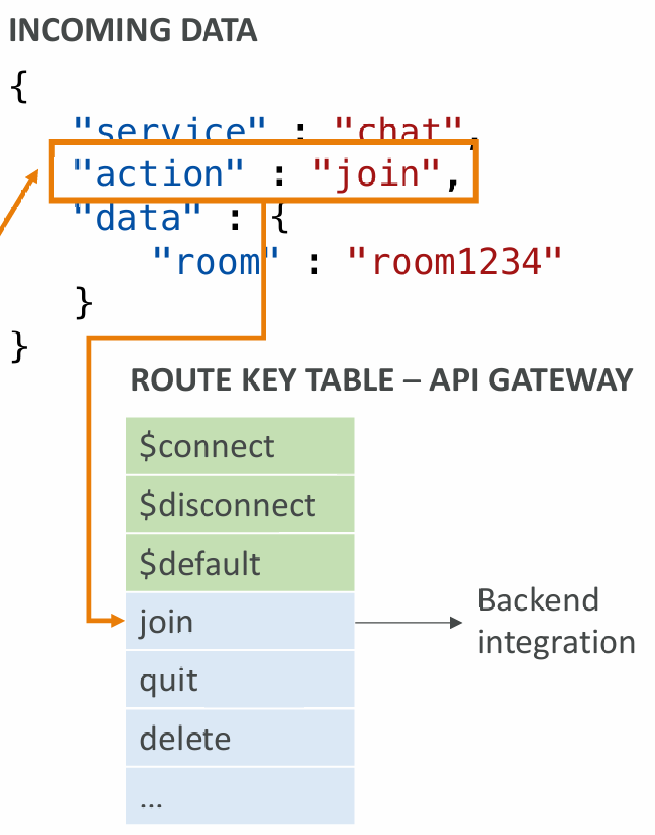API Gateway
- AWS Lambda + API Gateway: No infrastructure to manage
- Support for the WebSocket Protocol
- Handle API versioning (v1, v2…)
- Handle different environments (dev, test, prod…)
- Handle security (Authentication and Authorization)
- Create API keys, handle request throttling
- Swagger / Open API import to quickly define APIs
- Transform and validate requests and responses
- Generate SDK and API specifications
- Cache API responses
Architecture
- Create a single interface for all the microservices in your company
- Use API endpoints with various resources
- Apply a simple domain name and SSL certificates
- Can apply forwarding and transformation rules at the API Gateway level
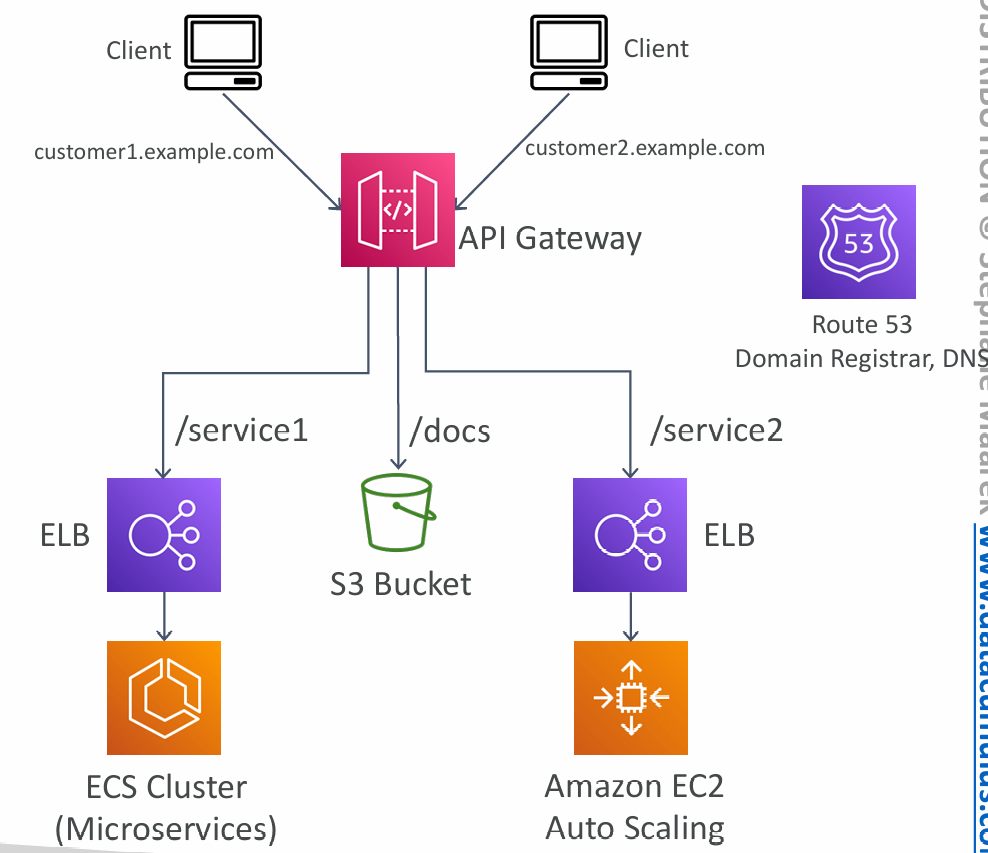
Integrations High Level
- Lambda Function
- Invoke Lambda function
- Easy way to expose REST API backed by AWS Lambda
- HTTP
- Expose HTTP endpoints in the backend
- Example: internal HTTP API on premise, Application Load Balancer…
- Why? Add rate limiting, caching, user authentications, API keys, etc…
- AWS Service
- Expose any AWS API through the API Gateway
- Example: start an AWS Step Function workflow, post a message to SQS
- Why? Add authentication, deploy publicly, rate control…
Example: Serverless API

Example: Kinesis Data Streams

Endpoint Types
- Edge-Optimized (default): For global clients
- Requests are routed through the CloudFront Edge locations (improves latency)
- The API Gateway still lives in only one region
- Regional:
- For clients within the same region
- Could manually combine with CloudFront (more control over the caching strategies and the distribution)
- Private:
- Can only be accessed from your VPC using an interface VPC endpoint (ENI)
- Use a resource policy to define access
Security
- User Authentication through
- IAM Roles (useful for internal applications)
- Cognito (identity for external users – example mobile users)
- Custom Authorizer (your own logic)
- Custom Domain Name HTTPS security through integration with AWS Certificate Manager (ACM)
- If using Edge-Optimized endpoint, then the certificate must be in us-east-1
- If using Regional endpoint, the certificate must be in the API Gateway region
- Must setup CNAME or A-alias record in Route 53
IAM Permissions
- Create an IAM policy authorization and attach to User / Role
- Authentication = IAM | Authorization = IAM Policy
- Good to provide access within AWS (EC2, Lambda, IAM users…)
- Leverages “Sig v4” capability where IAM credential are in headers
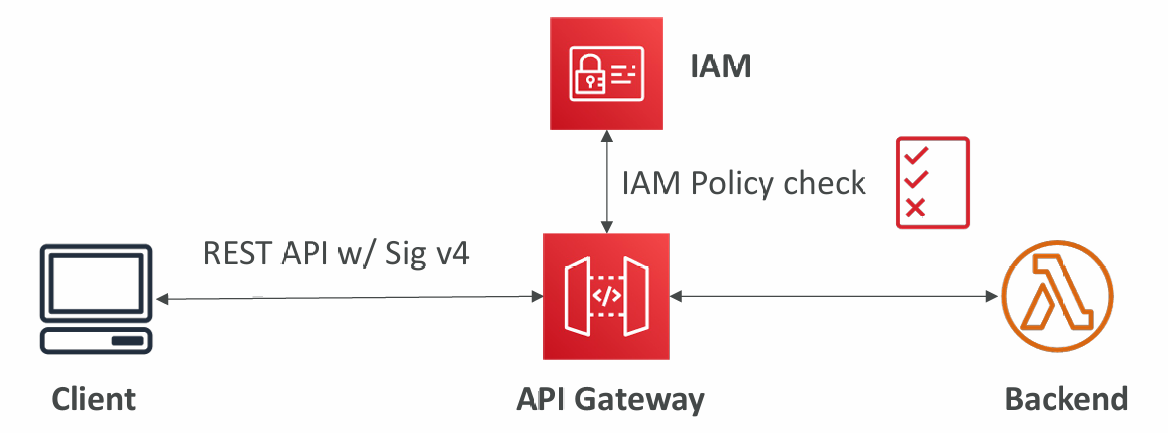
Resource Policies
- Resource policies (similar to Lambda Resource Policy)
- Allow for Cross Account Access (combined with IAM Security)
- Allow for a specific source IP address
- Allow for a VPC Endpoint
Cognito User Pools
- Cognito fully manages user lifecycle, token expires automatically
- API gateway verifies identity automatically from AWS Cognito
- No custom implementation required
- Authentication = Cognito User Pools | Authorization = API Gateway Methods
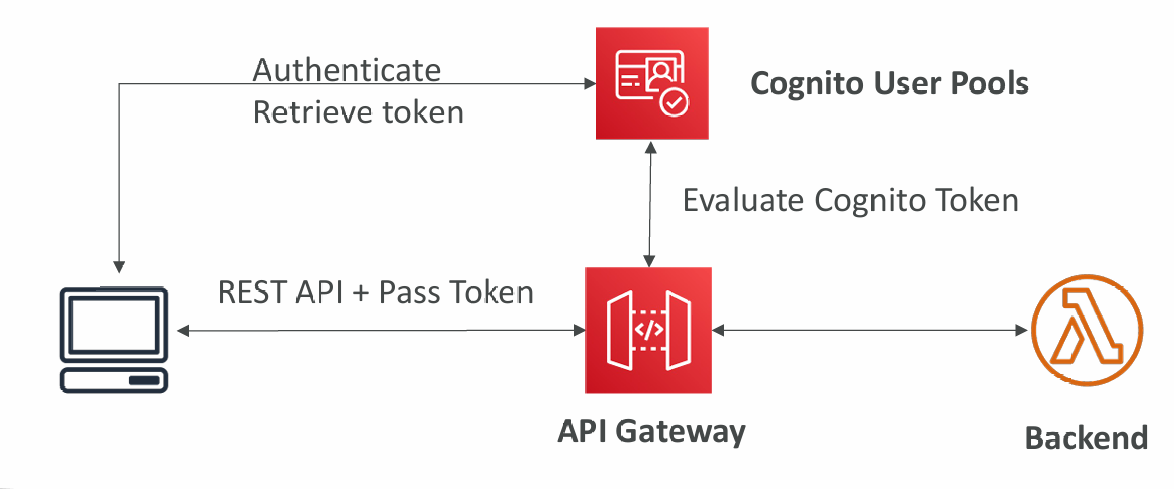
Lambda Authorizer (formerly Custom Authorizers)
- Token-based authorizer (bearer token) – ex JWT (JSON Web Token) or Oauth
- Arequest parameter-based Lambda authorizer (headers, query string, stage var)
- Lambda must return an IAM policy for the user, result policy is cached
- Authentication = External | Authorization = Lambda function

Summary
- IAM:
- Great for users / roles already within your AWS account, + resource policy for cross account
- Handle authentication + authorization
- Leverages Signature v4
- Custom Authorizer:
- Great for 3rd party tokens
- Very flexible in terms of what IAM policy is returned
- Need to handle Authentication verification + Authorization in the Lambda function
- Pay per Lambda invocation, results are cached
- Cognito User Pool:
- You manage your own user pool (can be backed by Facebook, Google login etc…)
- No need to write any custom code
- Must implement authorization in the backend
Deployment Stages
- Making changes in the API Gateway does not mean they’re effective
- You need to make a “deployment” for them to be in effect
- It’s a common source of confusion
- Changes are deployed to “Stages” (as many as you want)
- Use the naming you like for stages (dev, test, prod)
- Each stage has its own configuration parameters
- Stages can be rolled back as a history of deployments is kept
Stages v1 and v2 API breaking change

Stage Variables
- Stage variables are like environment variables for API Gateway
- Use them to change often changing configuration values
- They can be used in:
- Lambda function ARN
- HTTP Endpoint
- Parameter mapping templates
- Use cases:
- Configure HTTP endpoints your stages talk to (dev, test, prod…)
- Pass configuration parameters to AWS Lambda through mapping templates
- Stage variables are passed to the ”context” object in AWS Lambda
- Format:
${stageVariables.variableName}
Stage Variables & Lambda Aliases
- We create a stage variable to indicate the corresponding Lambda alias
- Our API gateway will automatically invoke the right Lambda function!
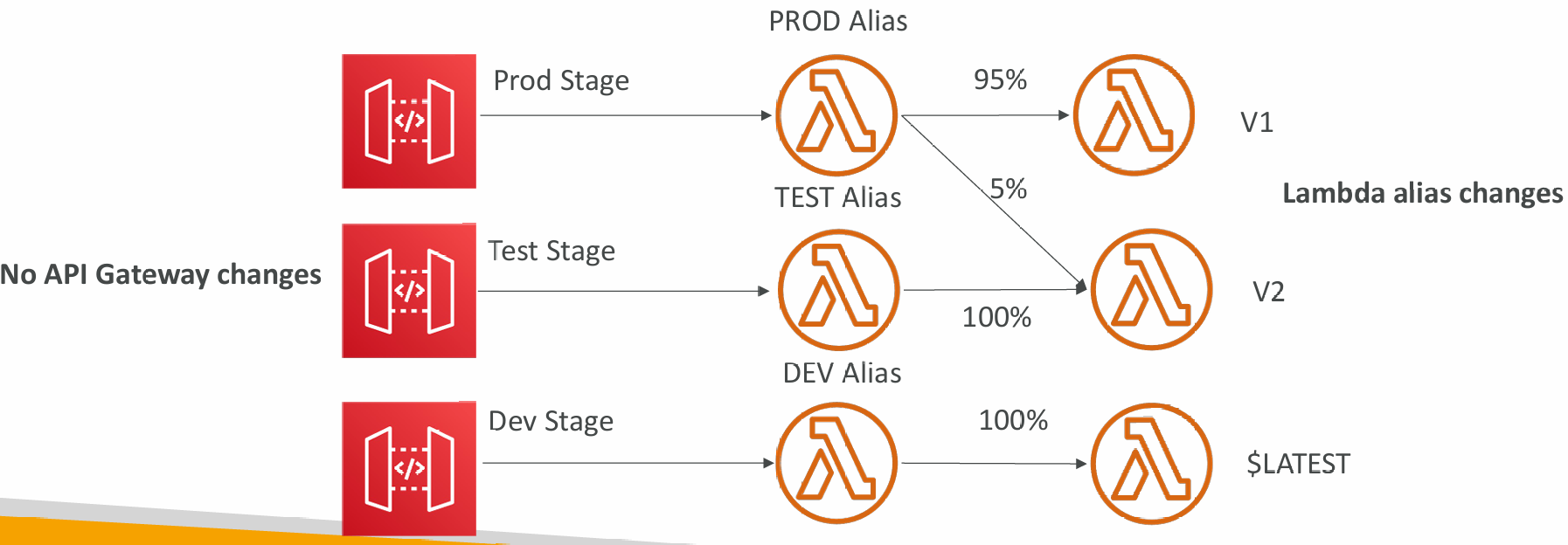
Canary Deployment
- Possibility to enable canary deployments for any stage (usually prod)
- Choose the % of traffic the canary channel receives

- Metrics & Logs are separate (for better monitoring)
- Possibility to override stage variables for canary
- This is blue / green deployment with AWS Lambda & API Gateway
Integration Types
- Integration Type MOCK
- API Gateway returns a response without sending the request to the backend
- Integration Type HTTP / AWS (Lambda & AWS Services)
- you must configure both the integration request and integration response
- Setup data mapping using mapping templates for the request & response

- Integration Type AWS_PROXY (Lambda Proxy):
- incoming request from the client is the input to Lambda
- The function is responsible for the logic of request / response
- No mapping template, headers, query string parameters… are passed as arguments

- Integration Type HTTP_PROXY
- No mapping template
- The HTTP request is passed to the backend
- The HTTP response from the backend is forwarded by API Gateway
- Possibility to add HTTP Headers if need be (ex: API key)

Mapping Templates (AWS & HTTP Integration)
- Mapping templates can be used to modify request / responses
- Rename / Modify query string parameters
- Modify body content
- Add headers
- Uses Velocity Template Language (VTL): for loop, if etc…
- Filter output results (remove unnecessary data)
- Content-Type can be set to application/json or application/xml
Mapping Example: JSON to XML with SOAP
-
SOAP API are XML based, whereas REST API are JSON based
-
In this case, API Gateway should:
- Extract data from the request: either path, payload or header
- Build SOAP message based on request data (mapping template)
- Call SOAP service and receive XML response
- Transform XML response to desired format (like JSON), and respond to the user

Mapping Example: Query String parameters
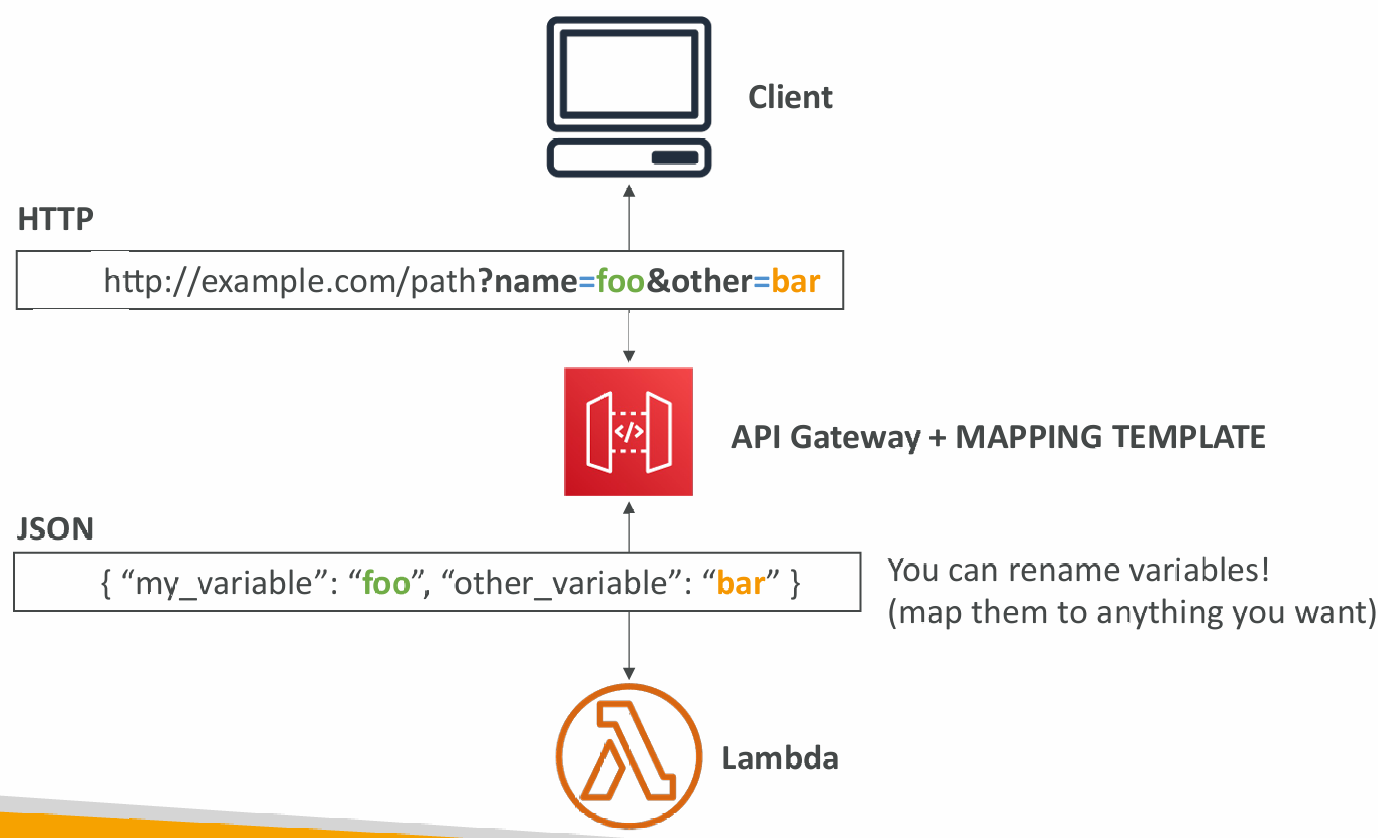
Open API spec
- Common way of defining REST APIs, using API definition as code
- Import existing OpenAPI 3.0 spec to API Gateway
- Method
- Method Request
- Integration Request
- Method Response
- + AWS extensions for API gateway and setup every single option
- Can export current API as OpenAPI spec
- OpenAPI specs can be written in YAML or JSON
- Using OpenAPI we can generate SDK for our applications
Request Validation
- You can configure API Gateway to perform basic validation of an API request before proceeding with the integration request
- When the validation fails, API Gateway immediately fails the request
- Returns a 400-error response to the caller
- This reduces unnecessary calls to the backend
- Checks:
- The required request parameters in the URI, query string, and headers of an incoming request are included and non-blank
- The applicable request payload adheres to the configured JSON Schema request model of the method
OpenAPI
- Setup request validation by importing OpenAPI definitions file
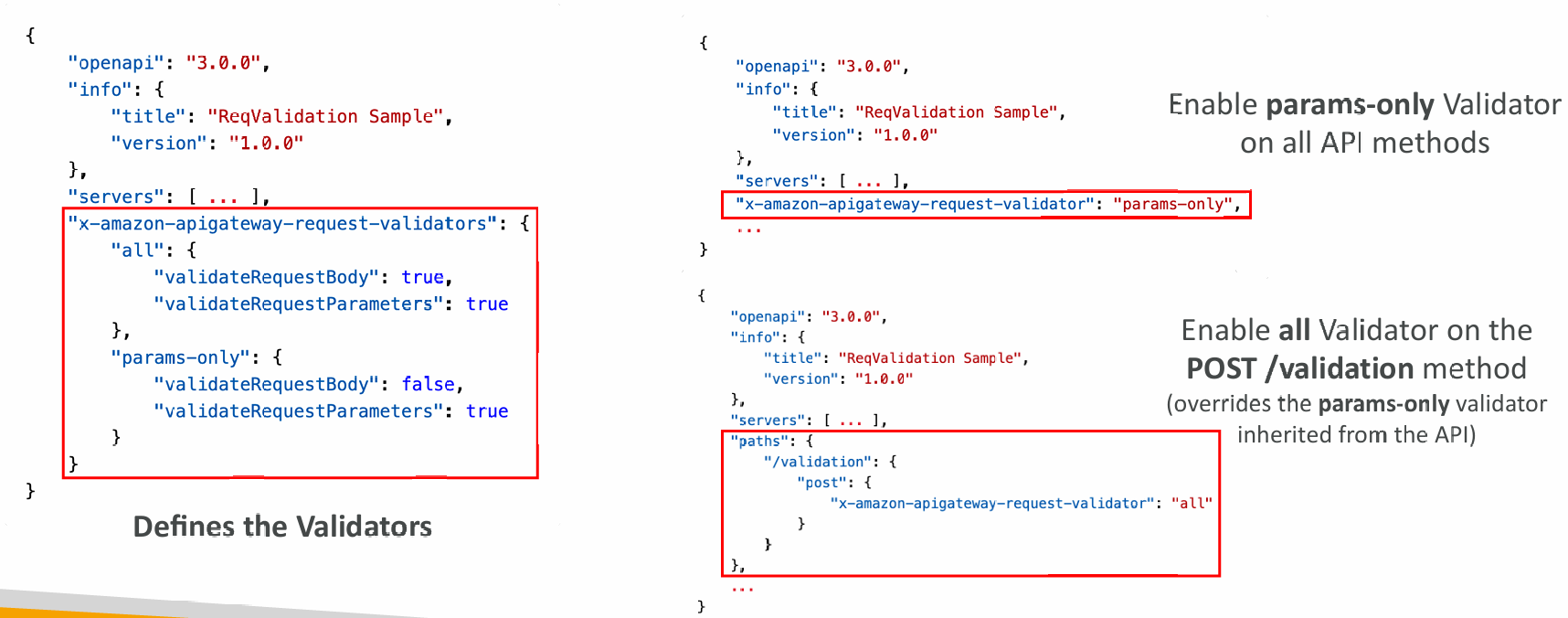
Caching API responses
- Caching reduces the number of calls made to the backend
- Default TTL (time to live) is 300 seconds (min: 0s, max: 3600s)
- Caches are defined per stage
- Possible to override cache settings per method
- Cache encryption option
- Cache capacity between 0.5GB to 237GB
- Cache is expensive, makes sense in production, may not make sense in dev / test
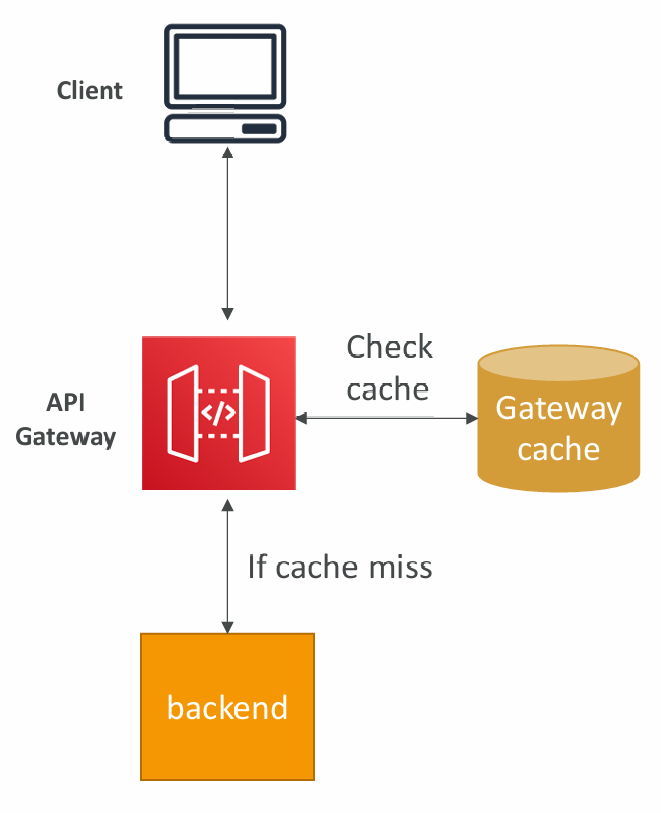
Cache Invalidation
- Able to flush the entire cache (invalidate it) immediately
- Clients can invalidate the cache with header: CacheControl: max-age=0 (with proper IAM authorization)
- If you don't impose an InvalidateCache policy (or choose the Require authorization check box in the console), any client can invalidate the API cache
Usage Plans & API Keys
- If you want to make an API available as an offering ($) to your customers
- Usage Plan:
- who can access one or more deployed API stages and methods
- how much and how fast they can access them
- uses API keys to identify API clients and meter access
- configure throttling limits and quota limits that are enforced on individual client
- API Keys:
- alphanumeric string values to distribute to your customers
- Ex: WBjHxNtoAb4WPKBC7cGm64CBibIb24b4jt8jJHo9
- Can use with usage plans to control access
- Throttling limits are applied to the API keys
- Quotas limits is the overall number of maximum requests
Correct Order for API keys
To configure a usage plan:
- Create one or more APIs, configure the methods to require an API key, and deploy the APIs to stages.
- Generate or import API keys to distribute to application developers (your customers) who will be using your API.
- Create the usage plan with the desired throttle and quota limits.
- Associate API stages and API keys with the usage plan.
Callers of the API must supply an assigned API key in the x-api-key header in requests to the API.
Logging & Tracing
- CloudWatch Logs
- Log contains information about request/response body
- Enable CloudWatch logging at the Stage level (with Log Level - ERROR, DEBUG, INFO)
- Can override settings on a per API basis
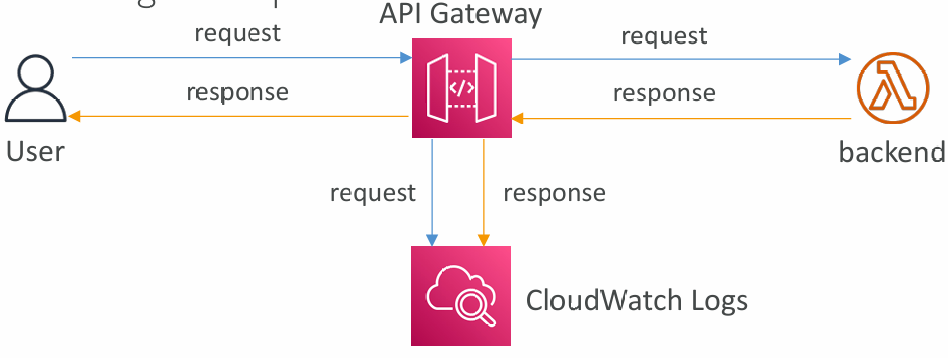
- X-Ray
- Enable tracing to get extra information about requests in API Gateway
- X-Ray API Gateway + AWS Lambda gives you the full picture
CloudWatch Metrics
- Metrics are by stage, Possibility to enable detailed metrics
- CacheHitCount & CacheMissCount: efficiency of the cache
- Count: The total number API requests in a given period.
- IntegrationLatency: The time between when API Gateway relays a request to the backend and when it receives a response from the backend.
- Latency: The time between when API Gateway receives a request from a client and when it returns a response to the client. The latency includes the integration latency and other API Gateway overhead.
- 4XXError (client-side) & 5XXError (server-side)
Gateway Throttling
- Account Limit
- API Gateway throttles requests at10000 rps across all API
- Soft limit that can be increased upon request
- In case of throttling => 429 Too Many Requests (retriable error)
- Can set Stage limit & Method limits to improve performance
- Or you can define Usage Plans to throttle per customer
- Just like Lambda Concurrency, one API that is overloaded, if not limited, can cause the other APIs to be throttled
Errors
- 4xx means Client errors
- 400: Bad Request
- 403: Access Denied, WAF filtered
- 429: Quota exceeded, Throttle
- 5xx means Server errors
- 502: Bad Gateway Exception, usually for an incompatible output returned from a Lambda proxy integration backend and occasionally for out-of-order invocations due to heavy loads.
- 503: Service Unavailable Exception
- 504: Integration Failure – ex Endpoint Request Timed-out Exception API Gateway requests time out after 29 second maximum
CORS
- CORS must be enabled when you receive API calls from another domain
- The OPTIONS pre-flight request must contain the following headers:
- Access-Control-Allow-Methods
- Access-Control-Allow-Headers
- Access-Control-Allow-Origin
- CORS can be enabled through the console
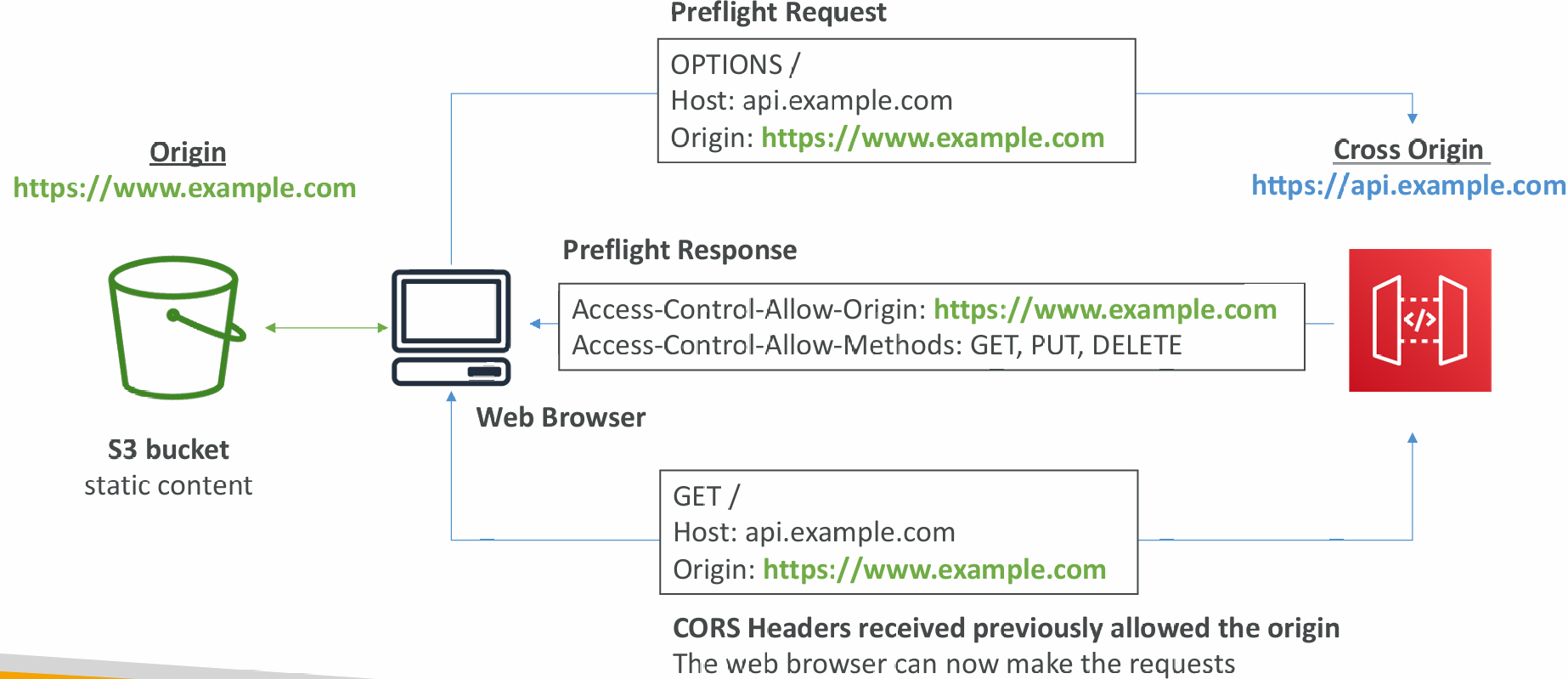
HTTP API vs REST API
- HTTP APIs
- very cheap
- low-latency, cost-effective AWS Lambda proxy, HTTP proxy APIs and private integration (no data mapping)
- support OIDC and OAuth 2.0 authorization, and built-in support for CORS
- No usage plans and API keys
- REST APIs
- All features (except Native OpenID Connect / OAuth 2.0)
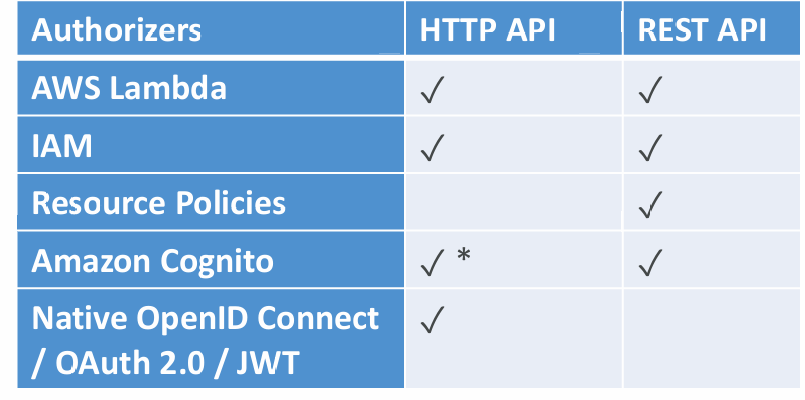
WebSocket API
- What’s WebSocket?
- Two-way interactive communication between a user’s browser and a server
- Server can push information to the client
- This enables stateful application use cases
- WebSocket APIs are often used in realtime applications such as chat applications, collaboration platforms, multiplayer games, and financial trading platforms
- Works with AWS Services (Lambda, DynamoDB) or HTTP endpoints
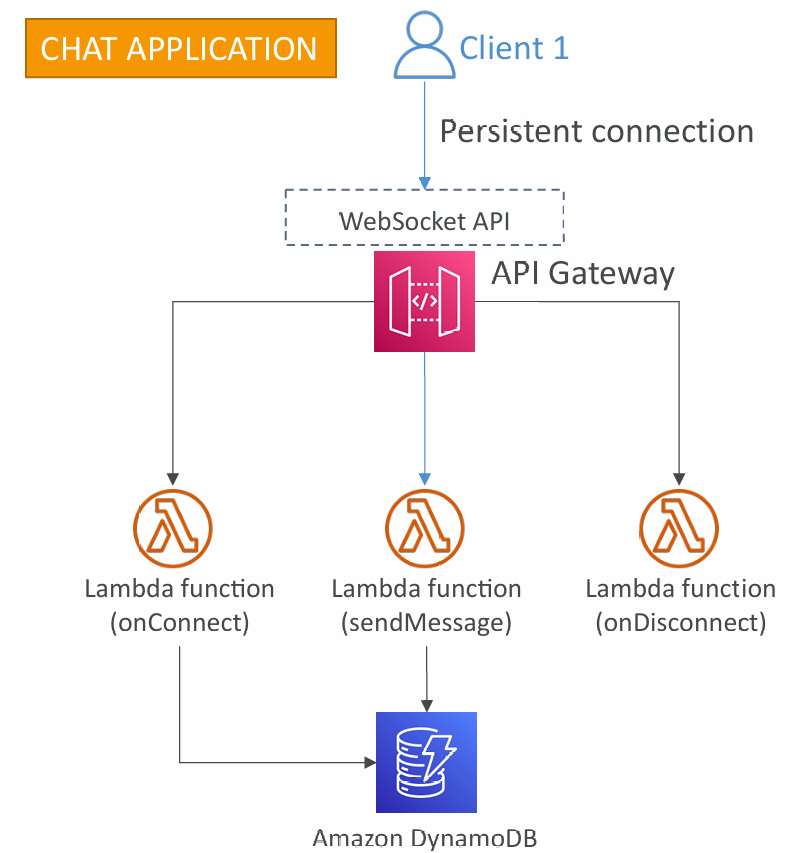
Connecting to the API

Client to Server Messaging
The ConnectionID is re-used:

Server to Client Messaging
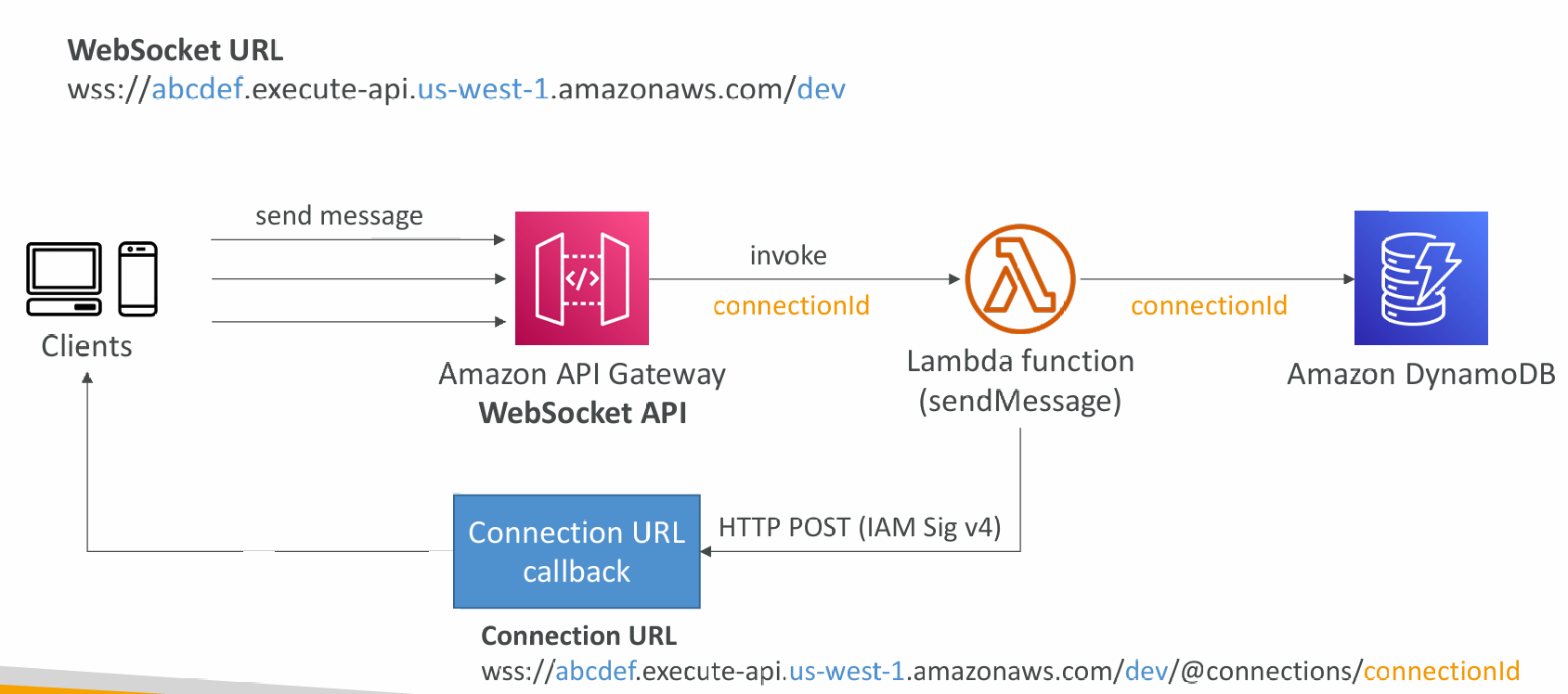
Connection URL Operations
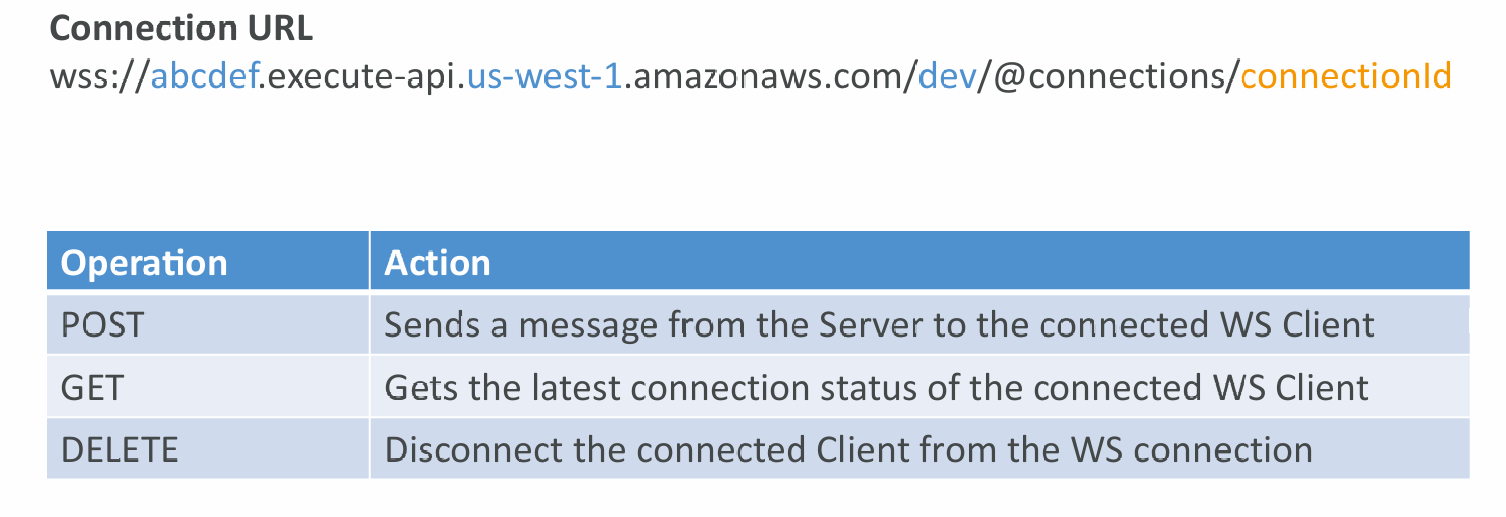
Routing
- Incoming JSON messages are routed to different backend
- If no routes => sent to $default
- You request a route selection expression to select the field on JSON to route from
- Sample expression:
$request.body.action - The result is evaluated against the route keys available in your API Gateway
- The route is then connected to the backend you’ve setup through API Gateway
